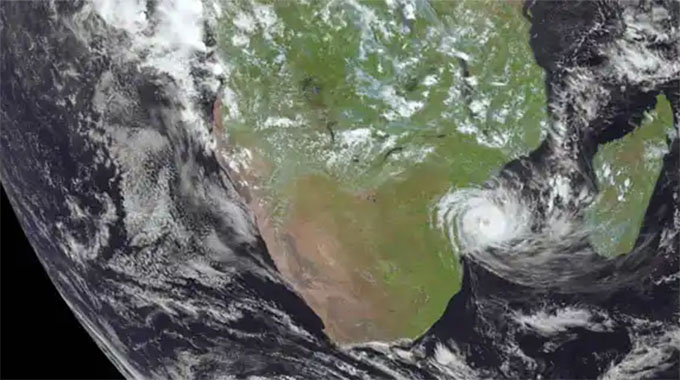Calm before Tropical Storm Freddy sets to unleash localised heavy rains

Sifelani Tsiko Agric, Environment & Innovations Editor
Tropical Storm Freddy will arrive later than expected over Zimbabwe as it slowed down as it crossed the Mozambique Channel, increasing its energy as it spent longer over the sea and delaying its landfall in southern Mozambique near Inhambane by 12 hours, the Meteorological Services Department (MSD) said yesterday.
Civil protection authorities remain on high alert in Zimbabwe, especially in the east and south which are areas likely to take the brunt of storm damage, floods and high winds in Zimbabwe.
The sunny weather over Zimbabwe yesterday was the calm before the storm that cyclones create, but the delay did mean that the winds rotating around the eye could be as fast as 120km/h at landfall as the storm picked up more energy in its slower-than-expected progress over the seas of the Mozambique Channel.
In its update yesterday afternoon, the Met Department said severe Tropical Storm Freddy creates a calm before the storm with sunny and warm conditions signalling that it is close.
“However, in a few hours, Freddy’s spinning cloud-bands, spanning more than 500km radius, should cause strong winds, although reduced to less than 75km/h (typical strong winds are usually 35km/h), increased cloudiness and localised heavy rains above 65mm.”
This is likely between today and Tuesday in districts such as Chimanimani, Chipinge, Chiredzi, Mwenezi, Beitbridge, Chivi, Masvingo Rural, Zaka, Bikita, Gutu and Buhera, said the department.
Climate experts say the slowing down of tropical storms means the storms have more time to build up energy as they cross seas.
Record-breaking tropical Cyclone Freddy which traversed more than 9000km across the entire southern Indian Ocean in 17 days, starting on 5 February from the seas north of Australia, made a landfall in eastern Madagascar on 21 February with sustained wind speeds of 150 km/h.
In Madagascar, it killed seven people, caused significant damage and left more than 78 000 people displaced.
According to projections, the storm would enter Mozambique in Inhambane Province, subsequently battering Gaza and Manica provinces and moving into Zimbabwe and South Africa.
Climate experts say Freddy was less intense and more compact than Batsirai which swept across southern Africa.
The Government has issued early warnings, ordering schools to suspend classes and boosting resources for disaster risk management to limit loss of life.
Districts in the most vulnerable areas have gone onto high alert with schools, churches and clinics identified as evacuation centres if needed, supplies on standby in district centres, and enough staff and assets mobilised and ready to react.
Matabeleland South provincial Civil Protection Unit (CPU) chairperson, Matabeleland South Secretary for Provincial Affairs and Devolution Ms Latiso Dlaminii said her province had gone on alert in Insiza, Gwanda and Beitbridge. Buses are in place for an evacuation, with the Grain Marketing Board on board for the provision of food in these centres. Medical supplies are being taken closer to district health centres,” said Ms Dlamini.
In February last year, Southern Africa hit by tropical cyclones Batsirai and Emnati – two of five tropical cyclones which caused devastation, death and destruction of infrastructure.
Tropical cyclones rank among the most deadly and most expensive of natural disasters.
Not only do their strong winds cause widespread destruction, the associated rainfall and storm surges add to the chaos by triggering floods and mudslides.
Africa has incurred economic losses of up to US$5 billion due to weather-related disasters that have hit the continent and other parts of the world over the past five decades, according to a 2021 World Meteorological Organisation report.
According to the WMO Atlas of Mortality and Economic Losses from Weather, Climate and Water Extremes (1970 – 2019), Africa recorded 1 695 disasters that caused the loss of 731 747 lives and $5 billion in economic losses.
The continent accounts for 15 percent of weather, climate, and water-related disasters, 35 percent of associated deaths and one per cent of economic losses reported globally.
Although disasters associated with floods were the most prevalent, at 60 percent, droughts led to the highest number of deaths, accounting for 95 per cent of all lives lost in the region, with most occurring in Ethiopia, Mozambique and Sudan.
Southern Africa has also not been spared from weather-related disasters. The region now sees more tropical cyclones every season, with global warming a principal cause as seas heat up.
Cyclone Eline of 2000, was one of the worst because of its associated floods. Southern parts of Mozambique, Zimbabwe, South Africa and Botswana were hardest hit, with two million people affected in Mozambique and 650 000 forced to abandon their homes.
Cyclone Idai of 2019 was recorded as one of the worst tropical storms to ever affect Africa and the southern hemisphere. It affected central and southern Mozambique, southern Malawi, and eastern Zimbabwe causing severe flooding and destroying infrastructure and large tracts of cropland in the three Sadc countries. An estimated three million people in the three countries were affected.











Comments